ALLIGATOR
BEHAVIOR page 5d: BABY ALLIGATORS--page
4 page 1 2 3 5 6 7 8 9 10 11 12
This
page was born 11/29/2012. Rickubis designed it. Last
update: 8/8/2020
Images
and contents on this page copyright ©2004 -2022 Richard M. Dashnau
ADDITIONAL--09/05/2005
I've
received a few questions since I posted the above story. The best
question
was: "Why is this necessary?", or, "Why do the alligators need
help
hatching?" I really should have mentioned this before, so here it
is.
When
we take the eggs away from a nest, a few things change. First,
they are
no longer in a "proper" alligator nest. Second, they are in less
natural
temperature and humidity.
Third, the female isn't protecting them.
The
alligator nest is usually a compost heap. It's a pile of rotting
vegetation
and mud. Bacterial action is what causes rotting. This gives heat
as a
by-product, and helps incubate the eggs. BUT--there may be some
effect
of the mud and grass on the egg shells. As time passes, bacterial
action-or
even soil acidity-may
help wear down the shells enough for the baby alligators
to break free. As the embryo develops, it also absorbs calcium
from the
egg shell. Even so, female alligators have been
observed gently cracking
the eggs in their mouth to help them hatch. So, our assistance
isn't necessarily
that different from what normally happens.
The
other factors; temperature
and so on, can affect the incubation time. By
observing the eggs we can usually tell if they are viable, or
alive. But,
we cannot tell when they are supposed to hatch. In this
batch,
a
few of the babies started breaking through the shells, so we knew
it
would be a good time. Even so, not all the eggs are exactly alike,
and
some may be a little less developed.
If we
don't
open the eggs, the baby alligators may not be able to break
through them,
and they will either suffocate or
starve
to death in the eggs. Generally, at least one nest a year
is
hatched
manually; and usually because a nest has had to have the eggs
removed for
some reason such as fire ant infestation, or flooding.
So,
it's a matter of educated guessing, and
sometimes testing the eggs.
Of course, if you hatch them too early, the babies are premature
and may
not live. If you wait too long, they may die in the shell. In four
years
at the park, I
have only seen successful hatchings.
In the
book Crocodiles: Inside Out, by Richardson, Webb, and
Manolis' pub.
2002; it says that American Alligators have the shortest
incubation time
of all the crocodilians. The book
says that most other species have an
incubation period of 11 to 14 weeks in the wild; while the
American Alligator
incubation takes about 9 weeks. (page 99) This is given as
an
adaptation
to the short period of time the eggs have to develop before the
weather
gets cold. If so, this is another example of why no other
crocodilian species
are likely to survive and
breed here.
The
book also states that hatching can be delayed or prevented if
dehydration
of the eggs is severe. (page 100).
To see
my other webpages about baby alligators and hatching see:Baby
Alligators 1;
Baby Alligators
2
August
28, 2005-- That's right. Baby
alligators!
Eggs were rescued from an alligator nest (fire ants had infested
the nest)
just a week ago, August 21. People were alerted that the eggs
were ready
to hatch by the appearance of an alligator nose through one of the
egg
shells. I was lucky enough to have this happen on my "park day",
so I was
able to be there with my camera.
Also, I got to hatch 3 eggs! This time,
they were almost hatching themselves, and when I held an egg and
started
to open it, the baby alligator inside would begin chirping. I
could feel
the
vibration through my fingers! Being near an alligator is a treat
for
me. Holding one is better. HATCHING one is even better! The image
below
(ANOTHER NEW ALLIGATOR) is a frame
from a video clip I shot of me hatching
the first one. You can see another frame below (see I
SMELL...AIR?, below,
or see the VIDEO
CLIP mp4).
I've
left the sound in this clip. Listen closely,
and you will hear the low
chirps of the baby from time to time. I shot the video
clip
using a tripod, and I put my hands where the camera was focused. I
had
fortunate results.
-------------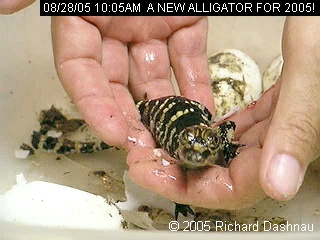 ---------------------
---------------------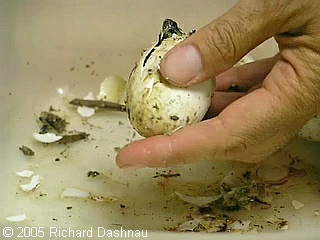
ANOTHER NEW
ALLIGATOR!
I
SMELL...AIR?
SHORT
VIDEO CLIP mp4
Below
is a sequence of pictures I shot of the second egg. As before, I'd
open
the shell, then take a picture with the camera in my right hand,
then do
the next step, and so on.
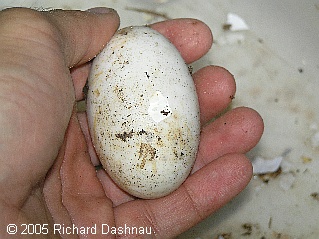 -
-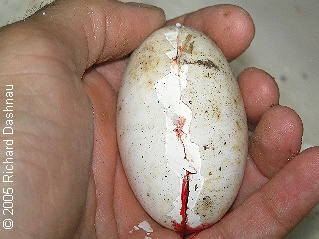 -
-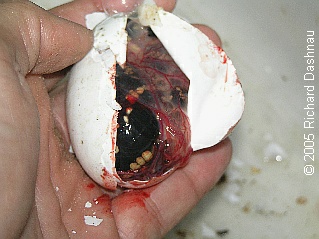 -
-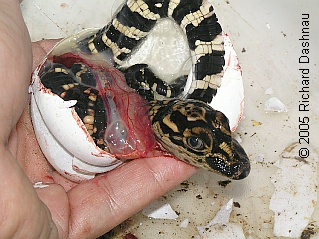
THE
EGG
LONG
SCISSOR CUT
MAN,
IT'S
TIGHT IN HERE
UNWRAPPED
PACKAGE
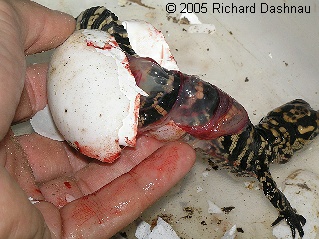
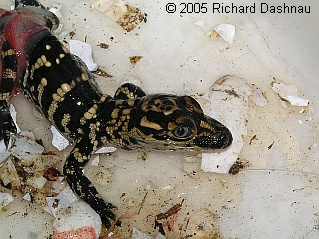 -
- 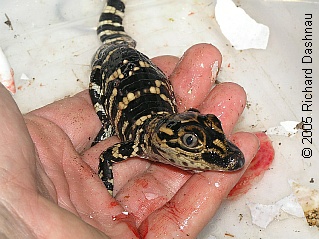
I'M FREE!
CAN
YOU
GET THIS MEMBRANE?
LOOKING UP AT RICK
Some
time ago, a park visitor asked me if alligators "imprint" (not in
those
words), that is, if they notice themselves to the first large
animal they
see and interpret it as their parent and begin
associating it with food
and protection. It was an interesting question, and I haven't
found anything
written about it. But, from experience, I would say "no, they
don't".
The
baby alligators don't
seem to recognise us as any kind of protection. Like
almost any animal, they can learn to associate us with food...but
they
don't treat us like they do a female alligator.
I've
seen baby alligators
in the wild with a parent. They will run or swim towards
it--while chirping--if they feel threatened. As far as I know,
even alligators
that have been captive for a year will not run towards a human if
they
are threatened. Another interesting behavior is what I've seen
these captives
do when released to a wild pod of babies with a parent. They will
also
start chirping, and move towards the
female alligator, just like the wild
babies do. If visited later, these "yearlings" that had been
captive show
no recognition to humans. They don't move towards them, and will
move closer
to
the female and/or chirp if approached. That's pretty cool
considering
they'd never seen a large adult before.
And,
images from my third egg are below. There was a hard, brittle
outer
covering;
and then a more flexible tough sheath underneath. The video
clip mp4 shows how each step works. We hatched out 17 eggs.
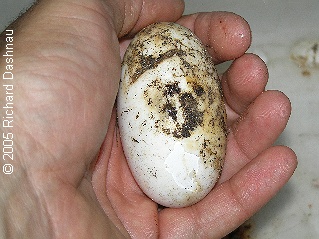 -
-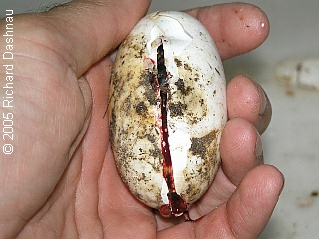 -
-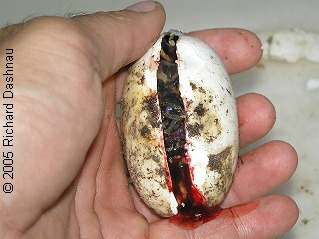 -
-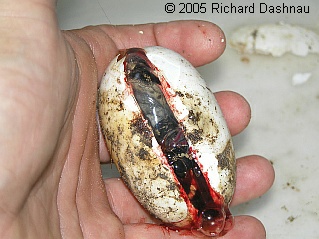
ANOTHER
EGG
LONG
SCISSOR
CUT
I CAN SEE MY
TAIL!
PUSHHH....
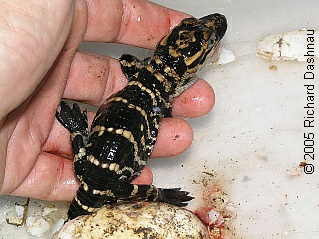
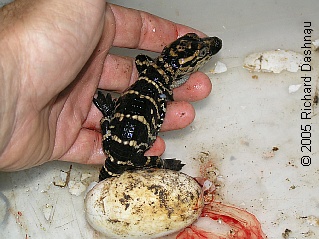 -
-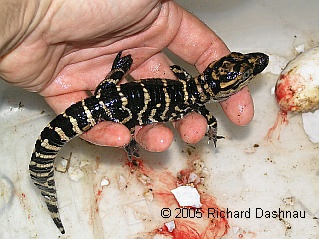
POP!
I'M STILL STUCK!
UNFOLDING AND RELAXING
September
23, 2004
The picture below shows a red-eared slider that is about one week
old,
hatched in the VC/NC at Brazos Bend State Park. Also in the
picture is
a quarter. (see BRAND
NEW TURTLE, below)
---------------------------------------------------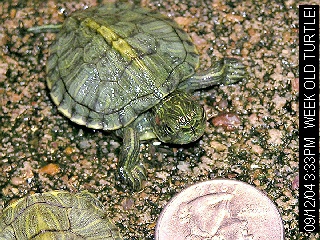
BRAND
NEW TURTLE
The
weeks between August 27 and September 20th were marked by various
hatchings.
The red-eared slider eggs were discovered when a huge dirt pile
(that had
been there for years) was
finally being used for road surfacing. One of
the rangers found them, and brought the eggs into the VC/NC.
Also
during this time, the alligator eggs that were found in an
abandoned nest
(the
mother alligator had died from unknown causes) and brought to the
VC/NC also began to hatch. This year, the eggs didn't hatch
together, so
there was no announcement of a mass-hatching,
and I didn't get to assist.
Out of the 27 eggs, 16 hatched successfully. One of the new
babies
can be seen sitting on my hand. See (WOW! SOME WORLD, below.) I
can't help
it. I just love
watching the young alligators as they look out at the world.
The
first of the outside nests to hatch (among those we could observe)
was
the nest on the island at 40 Acre lake (see the June 20 section
above).
This nest apparently hatched sometime
around August 22nd.
The
Creekfield nest (see the June 27 section above) was observed
hatching September
8 (I believe--I'll have to check). Some lucky people got to
observe the
mother alligator carrying the
babies from her nest to the water (at least
25 yards).
There
was some bad news. There was a nest on Pilant Slough, not far from
the
VC/NC, that was also being observed. After all these other
hatchings and
with no activity at this nest, it was
decided to inspect the eggs.
When the nest was opened (with careful observation of the female's
location),
it was discovered that the eggs were dead...and undeveloped. The
female
did come
and protect the nest, though. I wonder how long a female will
stay near a nest that has no live eggs in it. Perhaps now that
some of
the eggs have been opened, the smell will alert the female.
The
Slough has been inundated with high water at least once, and
probably twice,
this summer, both times since June. This was caused both
times by
the Brazos River and Big Creek being
swollen by rainwater from further
upstream. Because the eggs were undeveloped, I suspect that the
June event
drowned the nest. This is only a guess on my part, though. I
didn't see
the eggs,
and I intend to check for high water signs in the trees around
the nest.
September
12--This weekend and last weekend, a female alligator was observed
with
babies near the Observation Tower at 40 Acre Lake. On the 12th, I
could
just barely see her in this water
hyacinth (see MOM!, below), although
I could hear the babies. In the picture, the baby is gaping (The
next image
labels where they are.).
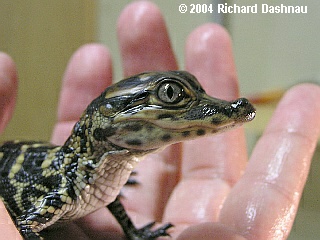 -
-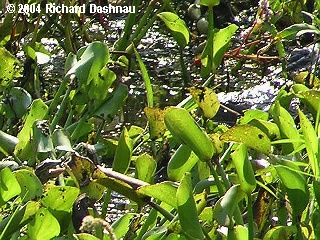 -
-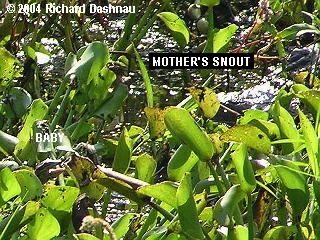 -
-
WOW!
SOME
WORLD
MOM!
MOM!--labeled
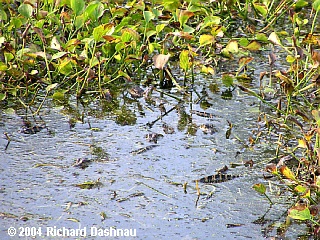
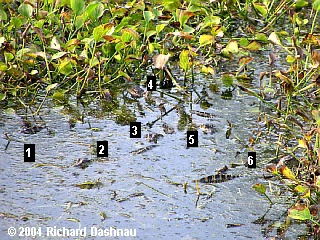
6
BABIES
6
BABIES--labeled
September
19--Apparently, the female who had the nest on the 40 Acre Lake
island
moved her young directly across the lake, and right near the 40
Acre Lake
Trail. Unfortunately, I was looking
into the sun, so they were hard to
photgraph. But, I tried anyway. The first image (6 BABIES, above)
*does*
show 6 baby alligators. The camouflage is amazing! The next image
labels
the alligators.
The next two pictures (5 OF THE SIX, and 3 AND 1/3
OF THE SIX) show closer views of the same group of alligators. The
last
image (THERE'S MOM!) shows the mother alligator's head (upper
left) and
one of the babies (lower right).
-----------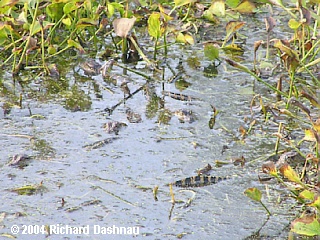 -----
-----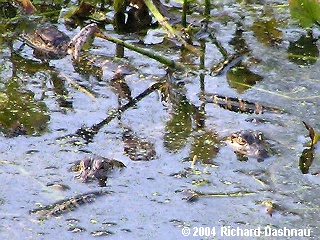 -------
-------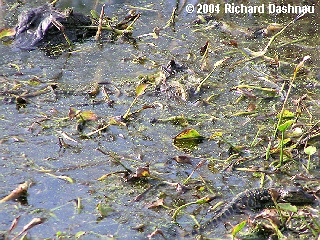
5 OF THE SIX
BABIES
3
AND 1/3 OF THE
SIX
THERE'S
MOM!
Finally,
here's a SHORT CLIP OF 2
BABY ALLIGATORS 693KB that I took with the Olympus
C-750.
June
27,2004--More alligator nesting
news!
An alligator has been seen walking back and forth on the
Creekfield trial.
Chuck and I went over to see what we could find. The alligator
wasn't visible,
but Chuck found a small mound which he thought might be a
nest. Later
in the afternoon, I heard that the alligator was seen again in the
same
spot, and when I hastened over there, I saw the
alligator lying on the
Creekfield trail (see GATOR CROSSING SIGN?, below). As I watched
with some
park visitors, she moved into the trees (see OK, I'll GO!, below).
Further
investigation showed
that Chuck's guess was probably correct, and this
was a female alligator building a nest about 15 feet from
the trail
(see GATOR IN THE SHADE, below). The nest is just barely
visible
a few feet
in front of her nose. I guess we'll see what happens next.
--------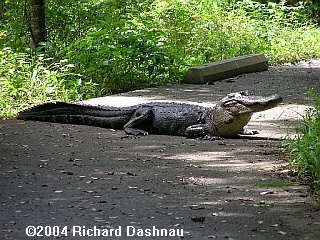 ----
----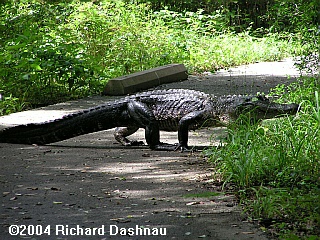 ---
---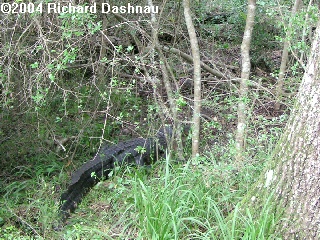
GATOR CROSSING
SIGN?
OK,
I'LL
GO!
GATOR
IN THE SHADE
June
20, 2004On
the same weekend, I found out that the first alligator nest was
discovered,
spotted by volunteer Rose Aden. This nest is on an island in 40
Acre Lake,
and is easily visible from
the trail, if you know where to look (any of
the volunteers or the naturalists can tell you where it is). The
picture
below (NEW NEST NO. 1, 2004) shows the nest, and also the female
next to
it (in the
right foreground). As usual, click on the image to see it a
bit larger.
--------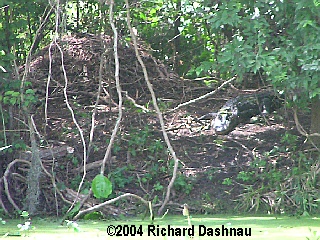 ----------------
----------------
NEW NEST NO.1, 2004
February
29, 2004
Today's weather was overcast and rainy, but some alligators came
out anyway.
The picture below (PROTECTIVE MOTHER) shows a female looking at me
over
a log. In front
of the log is a small group of her babies, and she's been
in this area with them since last August (see this
page, it shows her nest last August 7th). I often go
by and check
on her, and we usually
have a nice, quiet interaction. I respect her place,
and be sure to back off when she notices me. I like our eye-to-eye
contact,
and pride myself that she's never demonstrated any
aggressive
behaviors
towards me. I think it's very interesting that she moves carefully
and
silently while she tries to place herself between me and her
young.
It seems that a more noticeable behavior (like
hissing or splashing)
would drive more animals away. Perhaps she is unsure of what I'm
capable
of, and is sizing me up. This morning, she slowly turned towards
me (after
I'd been carefully moving
closer for about 5 minutes), and submerged to
get under the log. When she did, I quickly and quietly moved back
about
10 paces, so that when she surfaced, I was not where she expected
me to
be, and was further away (see AND STAY BACK!, below).
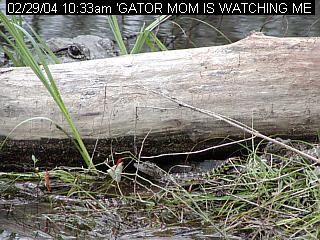 ---
---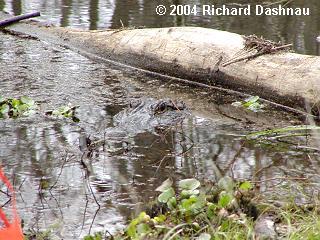 ----------
----------
PROTECTIVE
MOTHER
AND *STAY* BACK!
And,
this page shows alligators at the park, on
land, near various landmarks at the park.
Go back to my main alligator
page, Alligators
Go
back to my home page, Welcome
to rickubis.com
Go
back
to the RICKUBISCAM
page.
Go
back
to the See the
World
page.
 ---------------------
---------------------
 -
- -
- -
-

 -
- 





















